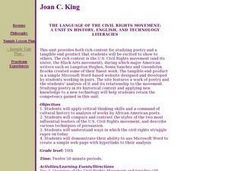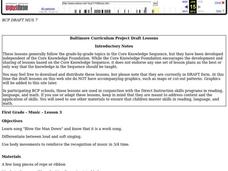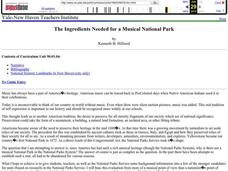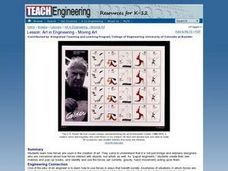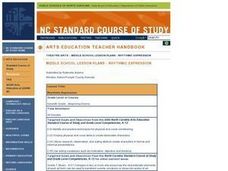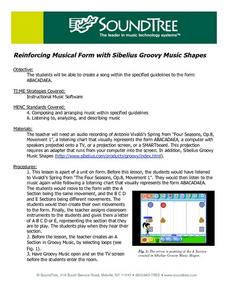Curated OER
The Language of the Civil Rights Movement:
Tenth graders study the poetry of the US Civil Rights movement and the Black Arts movement over a 12 day period. They author a website showing works of poetry that students have chosen to analyze and relate to these movements.
Curated OER
The History of Rock and Roll: Part 1 - Rock and Roll Explodes Music Reflects The Times
Students examine technological advancements in music and broadcast over the decades.
Curated OER
The History of Rock and Roll: Part 6 - My Generation Social an Cultural Influence on Music Composition
High schoolers examine influences on the creation and development of music.
Curated OER
The Language of the Civil Rights Movement
Tenth graders develop a website documenting poetry integral during the civil rights movement in the United States. Working in pairs, 10th graders research the people and poetry of that was prevalent during the civil rights movement. ...
Curated OER
Music
Third graders learn the song "Blow the Man Down" and know that it is a work song. They differentiate between loud and soft singing. They use body movements to reinforce the recognition of music in 3/4 time.
Curated OER
Classical Music
Students explore the history of music written during the classical era. They compare the melodic contours of specific thematic music, identifying the trills, slurs and articulations. As a class, students discus the characteristics of...
Curated OER
Exploring the Musical Shape of Student Names in a One-Computer Classroom
Students demonstrate musical direction while singing alone and with others while reading music. They discuss and demonstrate shapes that describe the music and compare that to melodic direction. Students make music out of the letters...
Curated OER
Activities Using Music From Saint-Saens & Moussorgsky
Student create a fish and listen to music while imagining their fish are swimming. In this music activity, students identify instruments played and move their fish to the movement. Students work with kangaroos and elephants...
Curated OER
The Ingredients Needed for a Musical National Park
Students identify musical sites that are worthy of being included as units of the National Parks System. They anthologize American music from primitive times to today.
Curated OER
Keyboard centers with Music You Can Read
Students play the letters provided in the format "Keyboard/Xylophone/Tone Bells" with the intention of using the "Music Only" format as skills progress. They study fingerings and chords when appropriate to skills.
Curated OER
Art in Engineering - Moving Art
Students study how forces are applied in the creation of art. They design mobiles and pop-up books while identifying which forces of nature act upon them. They look at air currents, gravity, and hand movement.
Curated OER
Animal Movement
Students participate in a movement to music activity. In this awareness of movement lesson, students hear music and move like animals they hear described in the music. Students make disciplined movements and make sounds...
Curated OER
And You Don't Stop - 30 Years of Hip-Hop, Episode 2, Lesson 1
Students discuss Public Enemy's lyrics and compare and contrast them with songs popular during the Civil Rights Movement. They write their own rap song that expresses feelings of oppression or freedom from oppression.
Curated OER
Rhythmic Expression
Young scholars discover movement and expression to music/sound through a series of teacher-led exercises and role plays. This instructional activity is ideal for the middle school drama class with possibilities for adaptation to any...
Curated OER
Going Up and Down
Second graders listen to and compare music to gain understanding of melodic direction in song, discuss types of movement in song, sing song while moving to it, and create movements that show pitches of melody moving upward, downward, or...
Curated OER
A New Twist on Race Relations
Learners analyze the impact of American Bandstand on race relations. In this race relations instructional activity, learners use the music and dance show American Bandstand to learn about race relations. Learners categorize pivotal...
Curated OER
Analyzing Two Dances and Making a Dance Map: The Nutcracker
Students discuss dance elements and create a dance map. They choose a dance theme and incorporate movement into their dance maps and choreography. They also experiment with different types of music.
Curated OER
Back to the Classics
Students closely examine chamber music as it has changed from the Middle Ages to today. They work in small groups to research the composers, instruments and typical presentation in 5 time periods. They write biographies and share their...
Curated OER
Art -- The Secret to Freedom
Fourth graders create a coded message in a quilt. In this art activity students demonstrate the communication used by the Underground Railroad. Students work in a group to make a quilt with a code in it.
Curated OER
Movement And Rhythm In Modern Art
Students gather around the three selected paintings. The teacher guide students in looking at different elements of the paintings and help students make the connections between the visual art and movement skills.
Curated OER
Rhythmic Pattern and Movement
Students practice repeating rhythmic patterns in unison. Next, students work in groups to practice an alternate rhythmic pattern to Row, Row, Row Your Boat. They create their own rhythmic patterns for the song.
Curated OER
Stone Passing Game with Calabash Song
Students discuss games and their use around the world in many different cultures and how music and games are related. They discuss the rules of West African game then play a game from West Africa and review and learn the "Calabash" song...
Curated OER
Pop Art-Reflections of the Mass Media
Young scholars select a common object or a face, and draw or paint it on a flat surface making it larger than real life. They choose a common object or simple scene and repeat it horizontally or vertically as defined rows. They create a...
Curated OER
Musical Form and Sibelius Groovy Music Shapes
Students create a song using the form ABACADAEA. Students listen to a musical piece created by Vivaldi that is an example of this musical form. Then
students use software to create their own musical forms representing this pattern.


